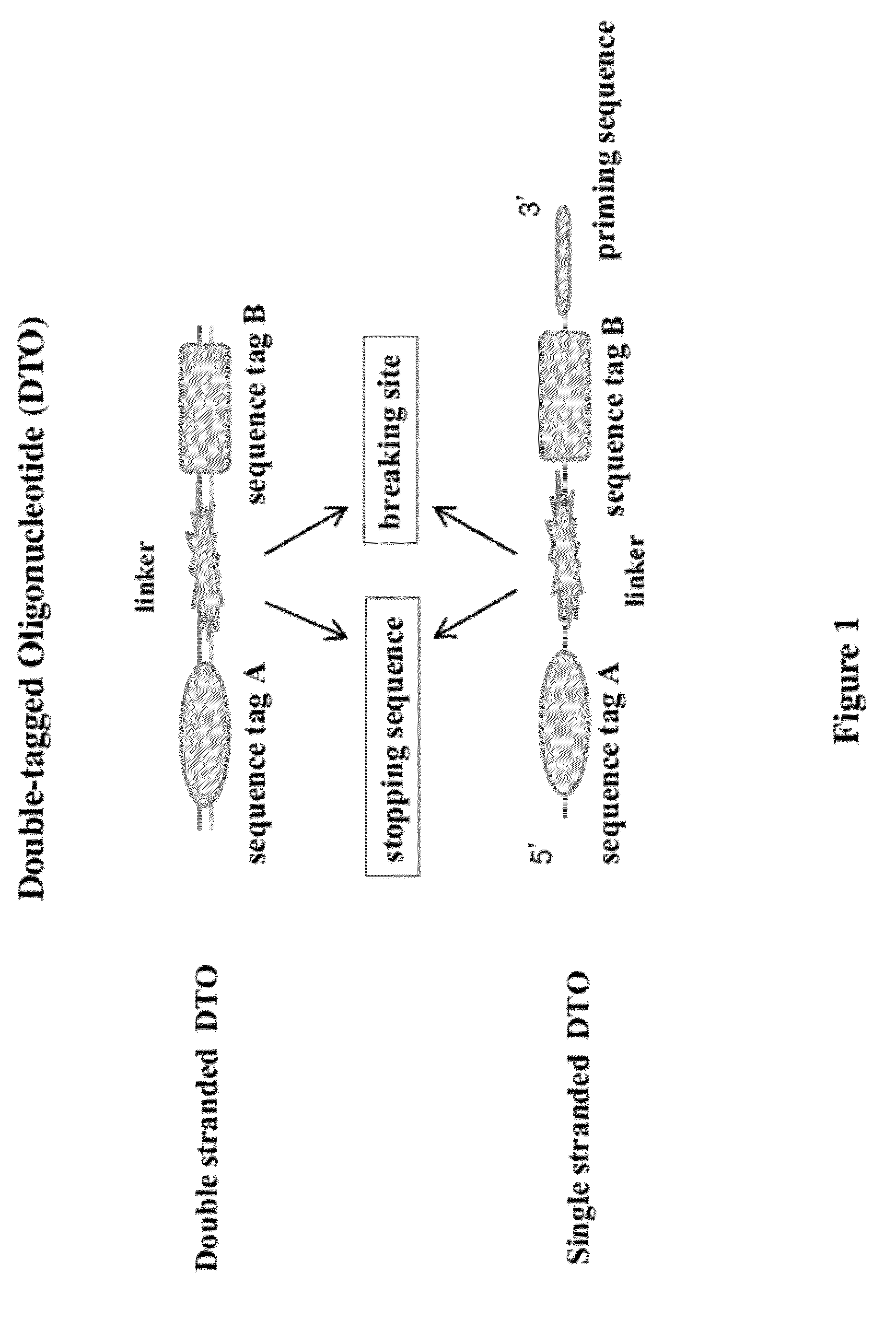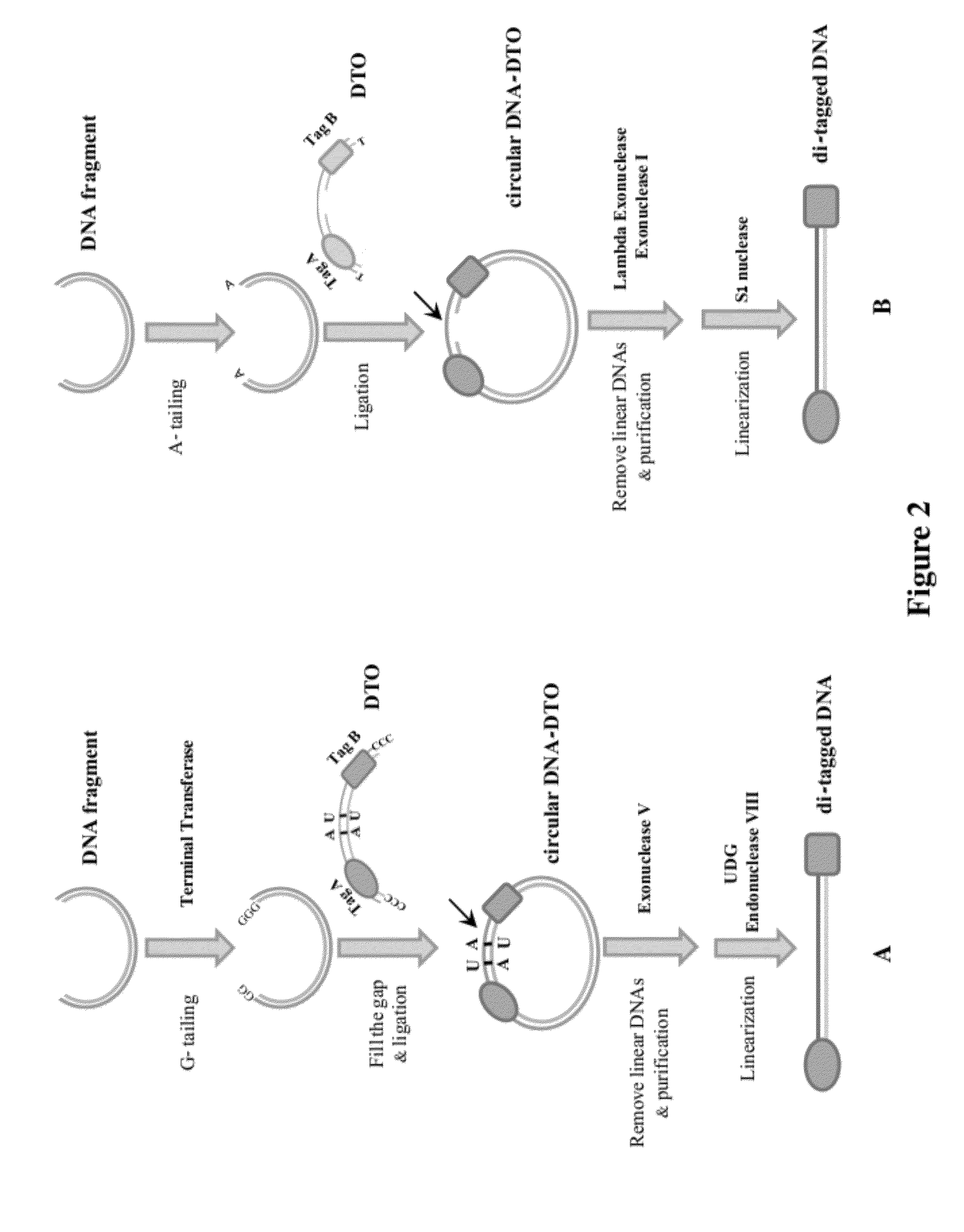Methods of making di-tagged DNA libraries from DNA or RNA using double-tagged oligonucleotides
a technology of oligonucleotide and dna, which is applied in the field of making double-tagged dna libraries using double-tagged oligonucleotides, can solve the problems of low yield of mate-pair dna, low ligation efficiency of biotinylated nucleotides, and still needs for selective pcr amplification, so as to prevent the generation of rolling cycle products
- Summary
- Abstract
- Description
- Claims
- Application Information
AI Technical Summary
Benefits of technology
Problems solved by technology
Method used
Image
Examples
example 1
A PCR-Free Method for Making a Di-Tagged DNA Library
[0081]Conventional methods randomly ligating two sequence tags to DNA fragments result in ligation products with only one tag, two of the same tag, and two different tags at ends of the DNA sequences. A PCR is needed to selectively amplify the ligation products with two sequence tags. This example (FIG. 2A) shows how to make di-tagged DNA libraries from DNA fragments using a double-tagged oligonucleotide. This method does not need PCR amplification or selection. The starting material is blunt ended DNA fragments. A DTO sequence having a sequence tag A, a breaking site, and a sequence B is used in this example. The breaking site of the DTO sequence has at least one Uracil nucleotide in each of two strands.
G-Tailing of DNA Fragments
[0082]Ligation efficiency between blunt end or A / T pair nucleotides is usually quite low. In order to increase ligation efficiency, Guanine nucleotides are added to 3′ OH terminus of DNA fragments using te...
example 2
Method for Making a Di-Tagged DNA Library Using a Gapped DTO
[0085]This example illustrates a method of making di-tagged DNA library from dsDNA fragments using a gapped dsDTO. The DTO has a sequence tag A, a single stranded gap (as a breaking site), sequence tag B, and a 3′ dT overhang (see FIG. 2B).
A-Tailing of DNA Fragments and Ligation of DNA Fragments & DTOs
[0086]The blunt ended DNA fragments are incubated with Taq DNA polymerase in the presence of only dATP and a single dA is added to the 3′ terminus of DNA fragments. DNA fragments with an A-overhang are ligated to DTO with a dT-overhang to form a circular DNA-DTO molecule. The circular DNA-DTO molecule has a single stranded gap with free 3′ and 5′ termini on the gapped strand. Lambda exonuclease that catalyzes removal of nucleotides from 5′ to 3′, but cannot act on nicks or gaps of a dsDNA, is used to remove unligated dsDNA, free dsDTO, and linear ligation products while leaving the circular ligation products intact. Exonucleas...
example 3
Method for Making a Mate Pair DNA Library Using a Double-Stranded DTO
[0088]This example shows a method of using a double-stranded DTO to make a di-tagged mate pair DNA library containing two DNA segments that are separated by several kilobases in the genome (FIG. 3). A DTO sequence having a sequence tag A, a uracil nucleotide on each of its two strand (as a breaking site), and a sequence tag B is used in this method. A 3′ dC overhang is added to the DTO sequences.
Ligation of DTO and Large DNA Fragments
[0089]Genomic DNA is fragmented into large DNA fragments of 2-3 kb in size, and is end-repaired to generate blunted end fragments having 5′ phosphate and 3′ OH. The large DNA fragments are incubated with Taq DNA polymerase in the presence of dGTP only. Taq DNA polymerase adds one single 3′ GMP overhang to blunt ended dsDNAs. The two ends of large DNA fragment with a single dG tail are ligated to a DTO with a dC overhang to form a large circular DNA-DTO molecule using T4 DNA ligases. Th...
PUM
| Property | Measurement | Unit |
|---|---|---|
| temperature | aaaaa | aaaaa |
| distance | aaaaa | aaaaa |
| elongation | aaaaa | aaaaa |
Abstract
Description
Claims
Application Information
 Login to View More
Login to View More - R&D
- Intellectual Property
- Life Sciences
- Materials
- Tech Scout
- Unparalleled Data Quality
- Higher Quality Content
- 60% Fewer Hallucinations
Browse by: Latest US Patents, China's latest patents, Technical Efficacy Thesaurus, Application Domain, Technology Topic, Popular Technical Reports.
© 2025 PatSnap. All rights reserved.Legal|Privacy policy|Modern Slavery Act Transparency Statement|Sitemap|About US| Contact US: help@patsnap.com



